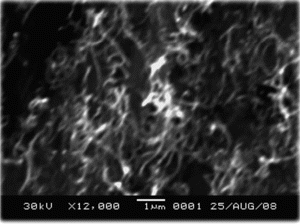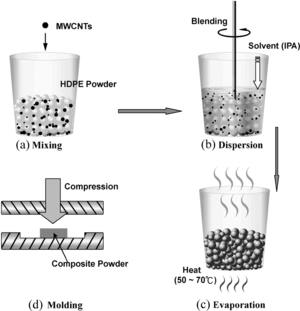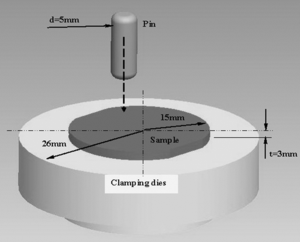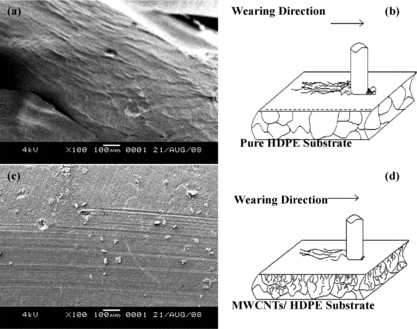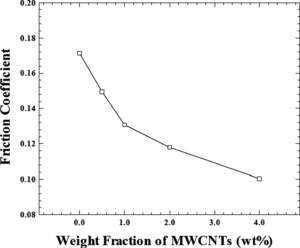Abstract
Studies have proved that increasing polymer matrices by carbon nanotubes to form structural reinforcement and electrical conductivity have significantly improved mechanical and electrical properties at very low carbon nanotubes loading. In other words, increasing polymer matrices by carbon nanotubes to form structural reinforcement can reduce friction coefficient and enhance anti-wear property. However, producing traditional MWCNTs in polymeric materix is an extremely complicated process. Using melt-mixing process or in situ polymerization leads to better dispersion effect on composite materials. In this study, therefore, to simplify MWCNTs /HDPE composite process and increase dispersion, powder was used directly to replace pellet to mix and sinter with MWCNTs. The composite bulks with 0, 0.5, 1, 2 and 4% nanotube content by weight was analyzed under SEM to observe nanotubes dispersion. At this rate, a MWCNTs/HDPE composite bulk with uniformly dispersed MWCNTs was achieved, and through the wear bench (Pin-on-Disk), the wear experiment has accomplished. Accordingly, the result suggests the sintered MWCNTs/HDPE composites amplify the hardness and wear-resist property.
INTRODUCTION
Carbon nanotubes (CNTs) have been widely applied for their specific electrical, thermal, and mechanical properties[ Citation 1 ]. Structural reinforcement of polymer matrices formed by carbon nanotubes has been broadly applied where significant improvement of mechanical properties was achieved at a very low carbon nanotube loading rate. However, because of the expenditure, single-wall carbon nanotubes (SWCNTs) are not prevalently adopted in structural reinforcement. Multi-wall carbon nanotubes (MWCNTs), on the other hand, are not only cheaper and easier to produce but also generate surprising mechanical properties compare to that of SWCNTs. The average strain modulus of MWCNTs estimated is over 1.8 TPa[ Citation 2 , Citation 3 ].
Owing to the above reasons, MWCNTs/polymer composite bulks have been studied to identify their response to heat, chemical corrosion, mechanical strain-stress, and electrics. However, these studies have mainly focused on the improvement of mechanical properties and electrical conductivity[ Citation 4 , Citation 5 ]. As in most fiber reinforced composite materials, in order to achieve the most efficient enhancement of properties, the reinforcement phase should be uniformly dispersed in a matrix. However, carbon nanotubes are strongly affected by Van de Wall's force which increases the possibilities of the formation of aggregates, which, in turn, make dispersion of MWCNTs in polymers difficult. Consequently, to overcome such aggregation of MWCNTs is a critical issue in the process of MWCNTs/polymer composites[ Citation 6 , Citation 7 ]. Currently, there are five common methods to disperse carbon nanotubes into polymeric matrices[ Citation8-10 ]: direct mixing, in situ polymerization, solution mixing, simplify melting extruder, and reduplicate melting process. While the direct mixing method usually applies to thermosetting polymers, the other four methods can be applied for thermoplastic polymers as well.
In the direct mixing method, carbon nanotubes are dispersed by mechanical blending along with sonic shaking and then mixed into a low-viscosity thermosetting resin[ Citation 11 ]. The resin in the mixture is then cured in a non-reversible polymerization reaction and result in a MWCNTs/polymer composite. On the process of in situ polymerization[ Citation 12 , Citation 13 ], the carbon nanotubes are mixed with polymer monomer and solution. The un-polymerized solution, containing the monomer and carbon nantubes, experiences a polymerization of high-temperature and high-pressure and hence forms a composite. Although direct mixing method is used to disperse carbon nanotubes in thermosetting polymers while in situ polymerization is used to disperse carbon nanotubes in thermoplastic polymers, the approach followed is quite similar.
In both methods, carbon nanotubes are initially added into a low-viscosity and a stable solution with well-dispersed carbon nanotubes which is obtained via blending. Finally the carbon nanotubes are locked into polymeric matrix by curing or polymerization. In the method of mixing solution, the solvent is used to dissolve solid thermoplastic polymer and carbon nanotubes are added into the resulting solution. The solvent is then gradually evaporated. Accordingly, the polymer re-solidifies, and a composite is eventually formed. However, the process is restricted to dissolve polymer only. For a chemical resistant polymer, such as high density polyethylene (HDPE), only a few toxic solvents (toluene and xylene) can be dissolved at elevated temperatures with low solubility.
In the method of simplify melting extruder, carbon nanotubes are mechanically dispersed into a polymer and melted by a compounder. The melted polymer is then extruded to induce the fluid viscous shear force to break nanotube aggregates or to prevent the formation of aggregates. Andrews et al.[ Citation 14 ] studied the CNTs/polymer composites by using four different polymer systems as the matrix: polypropylene (PP), acrylonitrile butadiene styrene (ABS), polystyrene (PS), and high impact polystyrene (HIPS). In their studies, they used a twin-screw extruder to blend the shearing action of the rotating screws, and then the filled polymers were further converted into films and fibers by a hydraulic press or an extruder, respectively. They concluded that low concentration of carbon nanotubes in polymer matrices generally resulted in an increase in Young's modulus but decrease in tensile strength; whereas at higher concentration, both stiffness and strength were greatly improved. Furthermore, a good dispersion of carbon nanotubes in the polymer matrix and a significant increase in the storage modulus were reported.
Although the simplified melting extruder process is simple and compatible with existing polymer processing techniques, the process is difficult to manipulate dispersion in high viscosity with high nanotube concentration[ Citation 9 ]. To improve the dispersion of high nanotubes concentration in melting polymer, the reduplicate melt processing has to break nanotube aggregates or prevent such formation. Tang et al.[ Citation 10 ] produced MCNTs/HDPE composites film in three steps. The first step is blending, heating and compressing to carry out the MWCNTs/HDPE sheet. The MWCNTs/HDPE sheet is then chopped into smaller pieces. However, this approach is not strong enough to break nanotube aggregates. To improve the dispersion of carbon nanotubes in polymer matrix, the prepared MWCNTs/HDPE composite pieces are fed into a twin-screw extruder to blend through the shearing by the rotating screws. Finally, the extrusive composite strip is compressed again to form a thin film. Although a good dispersion of carbon nanotubes in polymer matrix is achieved by reduplicating melt process, it is extremely complicated and expensive.
Research in the field of CNTs/polymer composites has been conducted on thermoplastics. However, to our knowledge, no hardness and wear-resisting properties have been reported. On the other hand, HDPE provides an excellent chemical resistance, high impact strength, good abrasive wear resistance, low coefficient of friction, as well as moderate stiffness and rigidity. It has broad biological and industrial applications, including orthopedic implants, artificial joint pads, corrosion-resisting structural materials, and vehicular parts. To utilize and enhance these properties of HDPE, especially on improving its hardness and wear-resistance, MWCNTs can be used to make bulk MWCNTs/HDPE composites. In this study, we replaced pellet with powder directly to blend and sinter with MWCNTs to simplify the process and increase dispersion.
The dispersion of carbon nanotubes in the polymer matrix was characterized by using SEM and through the wear bench (Pin-on-Disk) to carry out the wear experiment. The disadvantage of the conventional composite process is that it is extremely complicated and expensive. This approach, however, allows the process to come out a good dispersion of carbon nanotubes in the polymer matrix and significantly increase hardness and wear-resist property for the bulk composites with increasing MWCNTs content.
EXPERIMENTS
Materials
The matrix used in this study were a hot meltable high density polyester powder (HDPE 9002, Tm = 130°C, Formosa Plastics Group, TAISOX) with 50–100 µm in diameter and had a density of 0.954 g/cm3. The MWCNTs were purchased from Conyuan Biochemistry Technology Co., Ltd. (Taiwan). Figure illustrates a SEM image of the received MWCNTs. According to the specification of the manufacturer, the samples of nanotubes are 20–40 nm in diameter and about 5–15 µm in length. They were synthesized by catalytic chemical vapor deposition method. The samples produced from this method were nanotubes with approximately 90% nanoparticles and impurities.
Fabrication
The traditional approach to from MWCNTs in polymeric materix is an extremely complicated process. The two melt mixing process or in situ polymerization can result in better dispersion effect on composite materials. This study replaces pellet with powder directly to blend and sinter with MWCNTs in order to simplify the process and increase dispersion. Fabrication of MWCNTs/HDPE bulk samples for wear bench test can be described in two steps. The first step is the preparation of a precursor material in the form of MWCNTs/HDPE composite powder. Carbon nanotubes are mechanically dispersed into a HDPE powder by isopropyl alcohol (IPA) to blend in a hopper. The central idea is to use low-viscousity liquid and to stable the solution with well-dispersed nanotubes obtained by mixing.
The IPA solvent in mixer is evaporated in vacuum heating system and then is recycled via cooling distillation system. The procedure used to prepare the composite powder is shown schematically in Figures a–c. As shown in this figure, powder of neat HDPE, correct weight percentage of MWCNT powder and IPA solvent are blended in a hopper, heated in a vacuum oven at 60°C for 10 minutes to fully evaporate the dispersing solvent.
The second step is to feed the prepared composite powder into a hot compact mold to sinter, as shown in Figure d. In the sintering process, the temperature is maintained at 180°C for 2 hours to melt and sinter the composite powder to form a bulk MWCNT/HDPE composite. On the purpose of performing a standard wear test, the bulks are compressed and sintered to 5 mm in thickness. After the bulk is cooled down to the room temperature and washed, thin cylindrical test specimens of diameter 15 mm and thickness 5 mm are polished for the wear test.
Characterization of MWCNT Dispersion
Composite powder from the blending dispersion process, fabricated as the second step above, were characterized by scanning electron microscopy (SEM) to evaluate the dispersion of the MWCNTs in the HDPE matrix. The volume fraction of CNTs was determined by analyzing the carbon contents through an Elemental Analyzer (EA1110-FISONS) and a C/S analyzer (ELTRACS 800). Carbon nanotubes are clearly visible from the surface of the powdered polymer. Therefore, to see the carbon nanotubes in SEM, the sample is initially smeared over on a copper sheet and then the smeared surface is scanned in order to observe its microstructure. From the SEM observed, as shown in the Figure , the carbon nanotubes are uniformly dispersed and implanted within HDPE powder.
Performing a Wear Test to Characterize Mechanical Property
In order to evaluate the hardness and wear-resisting property for the bulk composites with increasing MWCNTs content, we constructed and implemented a pin-on-disk test technique similar to the one described by Archard[ Citation 15 ]. The approach of this test has several important advantages over the conventional wear-resistance test. First, the specimens required are only a few millimeters in thickness and diameter. In other words, the specimen is generated from a small amount of manufactured material, which is important since small specimens allow samples to be taken from different regions in a hopper component. The aspect allows one to evaluate the uniformity in mechanical properties in relatively small batch. Non-homogeneity of the properties can be intentionally engineered into the material, as in the making of a functionally graded nanocomposite, or an artifact. In either case, the small pin test can be used to characterize the degree of uniformity.
A small pin-on-disk test clamping dies apparatus used in the current study is depicted schematically in Figure . Wear tests were performed to evaluate the wear resistance under dry sliding condition. The wear tests were carried out at a sliding speed of 412 rpm, at applied load 97.88N and rotating distance of 8 mm using a hemispherical pin made by Co-Cr-Mo alloy. Several relative mechanical properties can be calculated from the wearing data of this test. On the other hand, the Shore hardness tests (Digital Shore-D Durometer Hardness Tester, HT-6510D, ASTM D 2240) were performed to evaluate the hardness of MWCNTs/HDPE composites.
RESULTS AND DISCUSSION
The MWCNTs/HDPE composite powder fabricated by the solvent blending process gives homogeneously dispersed MWCNTs within HDPE powder as shown in Figure . The most important feature of this process is to mix MWCNTs with HDPE powder in micro-structural level. That is, the MWCNTs are embedded or implanted within HDPE powder rather than attached on the surface of HDPE powder. The morphology of the MWCNTs/HDPE nanocomposite powder indicates an ideal composite microstructure, which displays the morphology of MWCNTs is uniformly dispersed and implanted in the powder. The fabricated MWCNTs/HDPE nanocomposite powder is consolidated into bulk MWCNTs/HDPE nanocomposite with full densification by a hot compacting mold to sinter. The photos of consolidated pure HDPE and MWCNTs/HDPE nanocomposite specimens are displayed in Figure (a) and the SEM image of a 4.0 wt% MWCNTs/HDPE nanocomposite is shown in Figure (b). The microstructure of consolidated MWCNTs/HDPE nanocomposites indicates homogeneous distribution of carbon nanotubes within the HDPE matrix.
FIG. 5 (a) The consolidated pure HDPE and MWCNTs/HDPE composites obtained after hot compacting sintering process and (b) SEM image of a 4.0 wt% MWCNTs/HDPE nanocomposite, which shows a homogeneous distribution of carbon nanotubes.
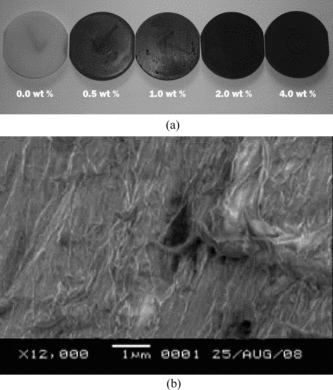
The hardness of the MWCNTs/HDPE nanocomposites measured by Shore-D hardness test is shown in Figure (a). A considerable enhancement of hardness is observed by extra MWCNTs in HDPE matrix. Compared to the pure HDPE matrix in which the MWCNTs loading fractions is 0.5 wt%, the MWCNTs/HDPE bulk composites induces a significant improvement of hardness. When the 0.5 wt% of MWCNTs is reinforced, the hardness of MWCNTs/HDPE nanocomposite is 63 MPa, which is about 1.1 times higher than that of HDPE without MWCNTs. In previous research, when the MWCNTs/polymer nanocomposites are fabricated by micro-structural level process, the huge contact area gives a strong physical bonding formed between the carbon nanotubes and the matrix, which provides homogeneous distribution of carbon nanotubes as well as high interfacial strength[ Citation 16 , Citation 17 ].
FIG. 6 (a) The variation of Shore-D hardness of MWCNTs/HDPE composites with varying the weight fraction of carbon nanotubes and (b) the variation of wear properties of MWCNTs/HDPE composite with varying the weight fraction of carbon nanotubes.

Therefore, it is confirmed that such remarkable enhancement of hardness by carbon nanotubes reinforcement is originated from a high interfacial strength at MWCNTs/HDPE interface, the homogeneous distribution of MWCNTs within HDPE matrix and the attained highly relative densities. Thus, base on this result, it can be concluded that the improvement of the hardness of MWCNTs reinforced nanocomposites is expected when the external load can be shared by homogeneously distributed MWCNTs through the load transfered from polymer matrix to MWCNTs by interfacial strength at MWCNT/polymer.
Figure (b) illustrates the wear loss and wear coefficient of MWCNTs/HDPE bulk composites which are evaluated by pin-on-disk wear test. The wear coefficient K is described by Archard[ Citation 15 ], K = W/(s × P), where W is the worn volume, s is the sliding distance, and P is applied load. Under dry sliding wear condition, the wear loss and wear coefficient of MWCNTs loading fractions of 0.5 wt% MWCNTs/HDPE bulk composites is reduced to 1/2 compared to those of pure HDPE matrix. This result suggests this nanocomposite presents high wear resistance by additional MWCNTs.
The microstructures of the worn surface of pure HDPE and MWCNTs/HDPE bulk composite were exhibited in Figures (a) and (c). The worn surface of the MWCNTs/HDPE composites indicates the nearly clear surface morphology as shown in Figure (c), while the pure HDPE shows flaked microstructure as shown in Figure (a). When the surface of pure HDPE flakes away during the wear process, the worn crumbs are formed by peeling HDPE worn surface as shown in Figure (b). However, in the case of MWCNTs/HDPE composite, the HDPE matrix are not easily peeled from the worn surface by the pinning of homogeneously implanted MWCNTs across HDPE internal structure as observed in SEM images of MWCNTs/HDPE composites. At the same time, the MWCNTs exposed to the worn surface during wear process can act as a lubricating carbon film owing to its low friction coefficient (Fig. (d)). Therefore, the friction coefficient of MWCNTs/HDPE composites is remarkably decreased with increasing weight fraction of MWCNTs due to the effect of homogeneous distribution of MWCNTs in HDPE matrix and lubrication of exposed MWCNTs on the worn surface as shown in Figure .
CONCLUSIONS
In conclusion, the MWCNTs/HDPE bulk composite with homogeneously dispersed carbon nanotubes within HDPE matrix can be fabricated directly by polymer powder to blend and sinter. The hardness and wear resistance property of fabricated MWCNTs/HDPE composite were significantly increased by increasing the weight fraction of carbon nanotubes. The remarkable enhancement of hardness is originated from the homogeneously distributed carbon nanotubes in HDPE matrix, excellent interfacial strength at MWCNTs/HDPE interfaces and high relative density of nanocomposites. The dispersed carbon nanotubes in HDPE-matrix composite provides considerably enhanced wear resistance by retarding the peeling of HDPE matrix during sliding wear process. It is concluded that the homogeneous distribution of carbon nanotubes with interface in matrix is an important technology issue to enhance the hardness and wear resistance property of MWCNTs/polymer composite.
ACKNOWLEDGMENTS
The financial support from the Oriental Institute of Technology and National Science Council NSC96-2221-E-161-004 and NSC96-2212-E-161-007 of R.O.C. (Taiwan) is greatly appreciated.
REFERENCES
- Ajayan , P.M. Nanotubes from carbon . Chemical Reviews 1999 , 99 , 1787 – 1800 .
- Zou , Y. ; Feng , Y. ; Wang , L. ; Liu , X. Processing and properties of MWNT/HDPE composites . Carbon 2004 , 42 , 271 – 277 .
- Park , C. ; Wilkinson , J. ; Banda , S. ; Ounaies , Z. ; Wise , K.E. ; Sauti , G. ; Lillejei , P.T. ; Harrison , J.S. Aligned single-wall carbon nanotube polymer composites using an electric field . Journal of Polymer Science B: Polymer Physics 2006 , 44 , 1751 – 1762 .
- Dufresne , A. ; Paillet , M. ; Putaux , J.L. ; Canet , R. ; Carmona , F. ; Delhaes , P. ; Cui , S. Processing and characterization of carbon nanotube/poly(styrene-co-butyl acrylate) nanocomposites . Journal of Material Science 2002 , 37 , 3915 – 3923 .
- Sandler , J. ; Shaffer , M.S.P. ; Prasse , T. ; Bauhofer , W. ; Schulte , K. ; Wind , A.H. Development of a dispersion process for carbon nanotubes in an epoxy matrix and the resulting electrical properties . Polymer 1999 , 40 , 5967 – 5971 .
- Lau , K.T. ; Hui , D. Effectiveness of using carbon nanotubes as nano-reinforcements for advanced composite structures . Carbon 2002 , 40 , 1605 – 1606 .
- Wood , J.R. ; Zhao , Q. ; Wagner , H.D. Orientation of carbon nanotubes in polymers and its detection by Raman spectroscopy . Composites A: Applied Science and Manufacturing 2001 , 32 , 391 – 399 .
- Jin , Z. ; Pramoda , K.P. ; Goh , S.H. ; Xu , G. Poly(vinylidene fluoride)-assisted melt-blending of multi-walled carbon nanotube/poly(methyl methacrylate) composites . Material Research Bulletin 2002 , 37 , 271 – 278 .
- Pötschke , P. ; Fornes , T.D. ; Paul , D.R. Rheological behavior of multi-walled carbon nanotube/polycarbonate composites . Polymer 2002 , 43 , 3247 – 3255 .
- Tang , W. ; Santare , M.H. ; Advani , S.G. Melt processing and mechanical property…polyethylene (MWNT/HDPE) composite films . Carbon 2003 , 41 , 2779 – 2785 .
- Gojny , F.H. ; Nastalczyk , J. ; Roslaniec , Z. ; Schulte , K. Surface modified multi-walled carbon nanotubes in CNT/epoxy-composites . Chemical Physics Letters 2003 , 370 , 820 – 824 .
- Park , C. ; Ounaies , Z. ; Watson , K.A. ; Crooks , R.E. ; Smith , J.J. ; Lowther , S.E. ; Connell , J.W. ; Siochi , E.J. ; Harrison , J.S. ; Clair , T.L.S. Dispersion of single wall carbon nanotubes by in situ polymerization under sonication . Chemical Physics Letters 2002 , 364 , 303 – 308 .
- Jia , Z. ; Wang , Z. ; Xu , C. ; Liang , J. ; Wei , B. ; Wu , D. ; Zhu , S. Study on poly(methyl methacrylate)/carbon nanotube composites . Materials Science and Engineering A 1999 , 271 , 395 – 400 .
- Andrew , R. ; Jacques , D. ; Minot , M. ; Rantell , T. Fabrication of carbon multiwalled nanotube/polymer composites by shear mixing . Macromolecular Materials and Engineering 2002 , 287 , 395 – 403 .
- Archard , J.F. ; Peterson , M.B. ; Winer , W.O. , eds. Wear Theory and Mechanisms in Wear Control Handbook , New York , ASME 35 – 80 , 1980 .
- Cha , S.I. ; Kim , K.T. ; Arshad , S.N. ; Mo , C.B. ; Hong , S.H. Extraordinary strengthening effect of carbon nanotubes in metal-matrix nanocomposites processed by molecular-level mixing . Advanced Materials 2005 , 17 , 1377 – 1381 .
- Cha , S.I. ; Kim , K.T. ; Lee , K.H. ; Mo , C.B. ; Hong , S.H. Strengthening and toughening of carbon nanotube reinforced alumina nanocomposite fabricated by molecular level mixing process . Scripta Materials 2005 , 53 , 793 – 797 .
